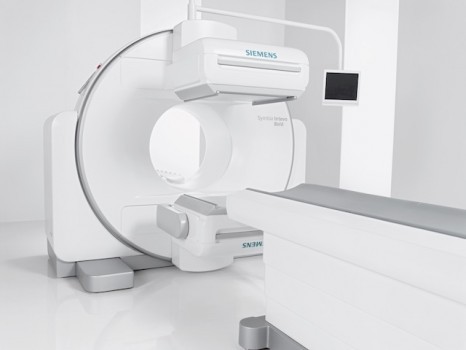December 18, 2017 - Siemens new "dual-use capabilities of SPECT/CT enabl[es] exceptional image quality in both forms of imaging at the lowest possible patient dose,” says Jim Williams, head of Siemens Healthineers Molecular Imaging.
Siemens Healthineers (Malvern, Pa) aims to meet the growing trend of health care facilities using SPECT/CT systems in a dual-use setting, mirroring the rise of dual-use positron emission tomography (PET)/CT, with the debut of the Symbia Intevo Bold SPECT/CT system, at the 2017 annual meeting of the Society of Nuclear Medicine & Molecular Imaging. . This new SPECT/CT combines the company’s single-photon emission computed tomography (SPECT) technologies with new, high-performance CT capabilities to enable a wide range of clinical applications.
According to Siemens, more facilities are utilizing SPECT/CT systems as standalone or backup diagnostic CT systems. Additionally, institutions are looking to maximize efficiency for SPECT patients who also require a diagnostic CT scan by acquiring both sets of images on the same system. For these reasons, demand is increasing for SPECT/CT systems with optimal CT capabilities. Addressing that demand, the new Symbia Intevo Bold offers a host of optional applications that bolster the CT imaging capabilities of SPECT/CT.

Available on a Siemens Healthineers SPECT/CT system for the first time, the Sinogram Affirmed Iterative Reconstruction (SAFIRE) algorithm is designed to deliver excellent CT image quality while reducing patient radiation dose by as much as 60%. SAFIRE enables fast image reconstruction for easy implementation into a facility’s clinical routine. Additionally, SAFIRE reduces noise while maintaining detail visualization.
Also available for the first time on any of the company’s SPECT/CT systems, the Iterative Metal Artifact Reduction (iMAR) algorithm reduces metal-related artifacts caused by metallic materials, such as orthopedic and dental implants. With this capability, customers can not only curb or eliminate artifact-induced distortion in CT images but also apply the CT images for attenuation correction to provide a more enhanced, accurate SPECT image.
The optional interleaved volume reconstruction (IVR) feature of Symbia Intevo Bold reconstructs overlapping CT images up to 32 slices to extract the maximum amount of diagnostic information from measured data, enabling evaluation of small structures such as lesions or fractures. IVR improves spatial resolution in the z-direction of all CT scans, regardless of pitch.
Finally, the single-source dual energy capability of Symbia Intevo Bold employs two sequential spiral CT scans operating at different kV levels to combine tissue information with disease morphology, improving image quality. Post-processing applications with the company’s syngo Dual Energy software include monoenergetic, Calculi Characterization, and gout.




